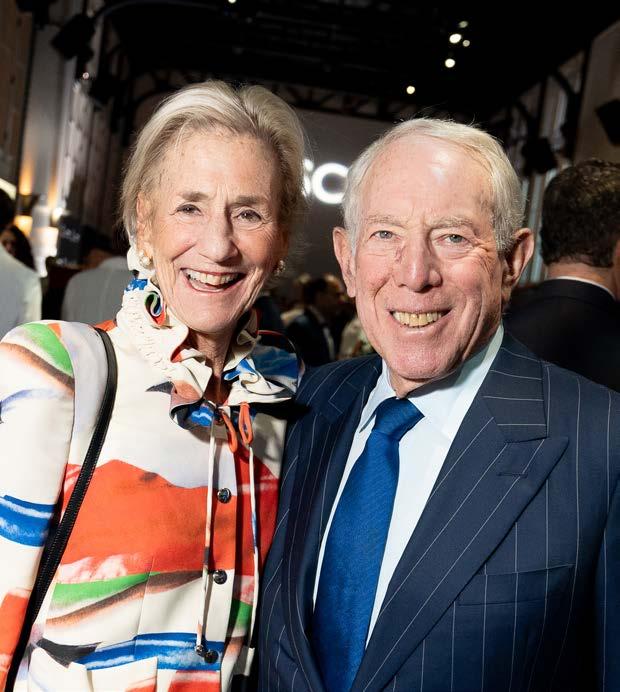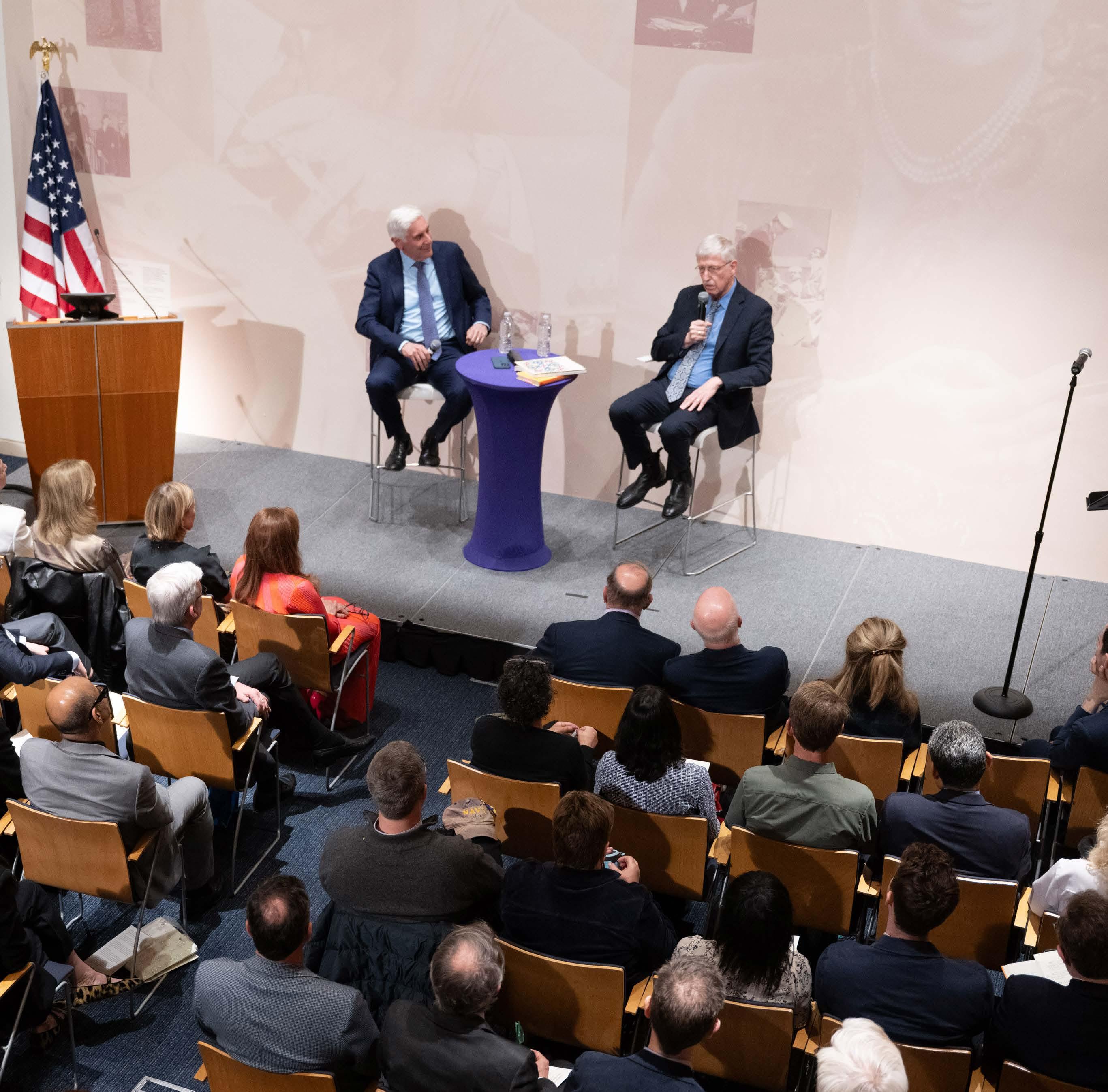
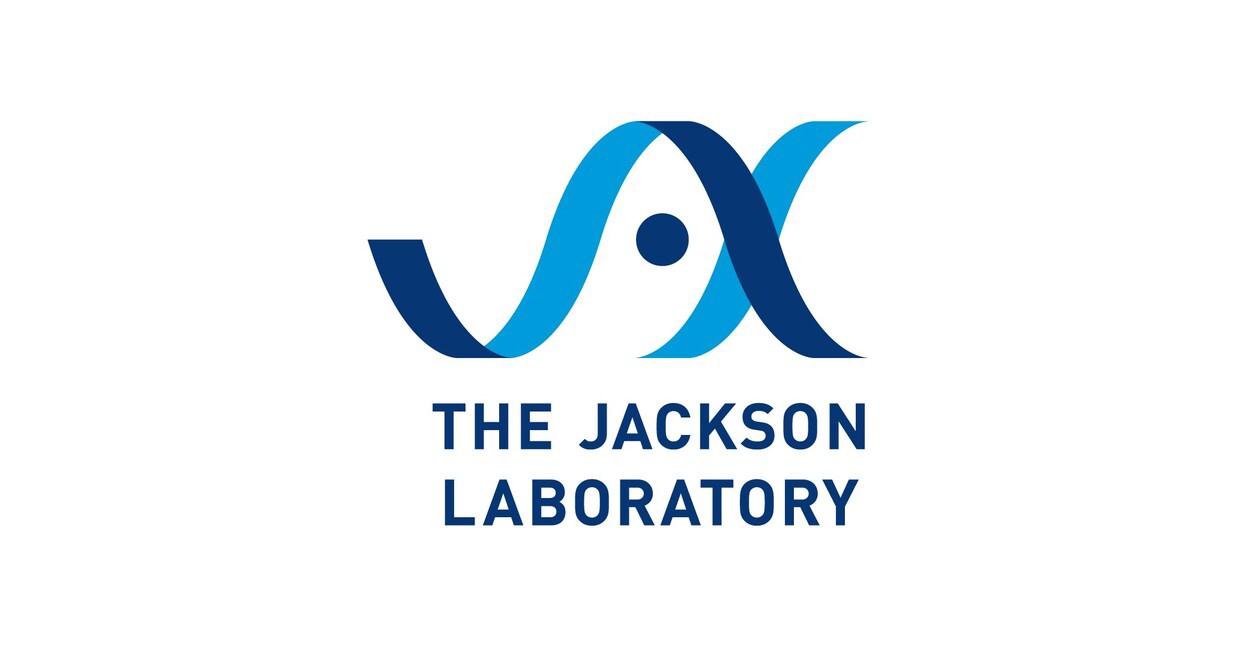
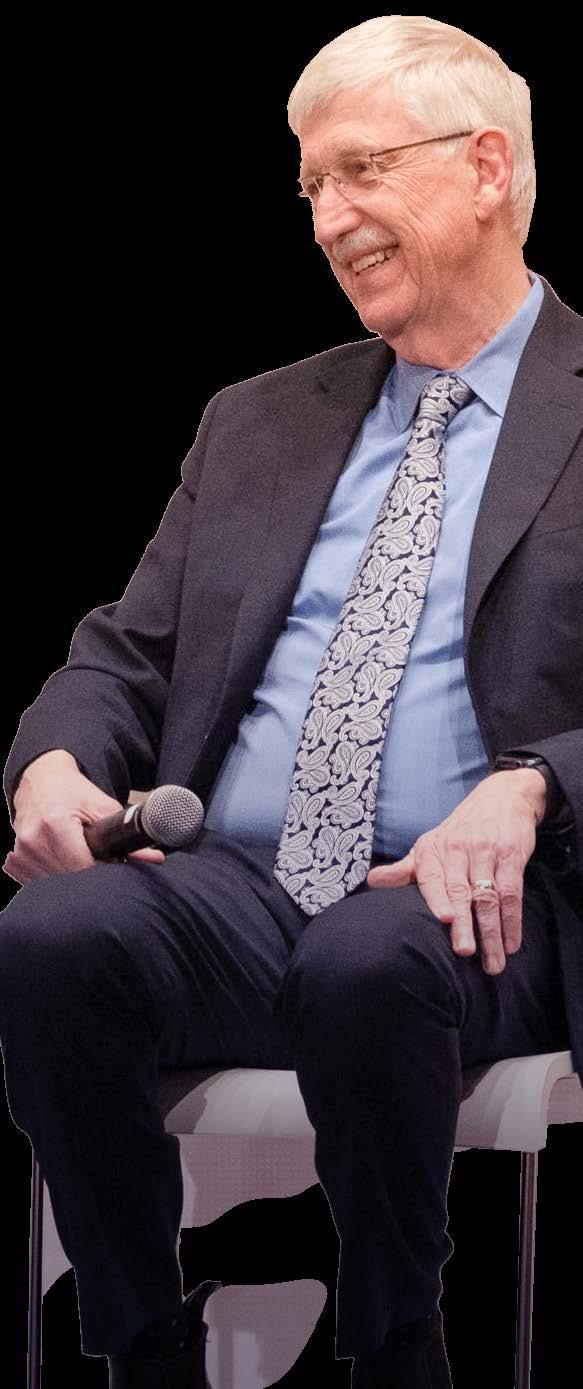
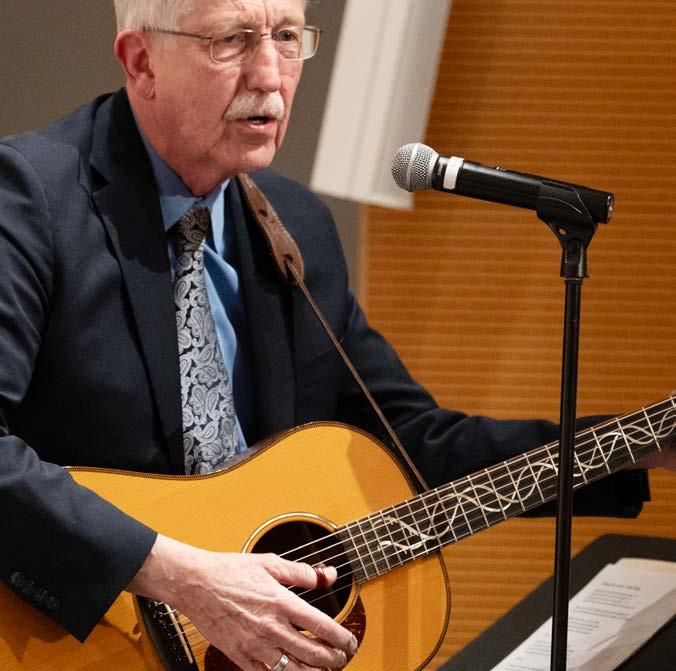
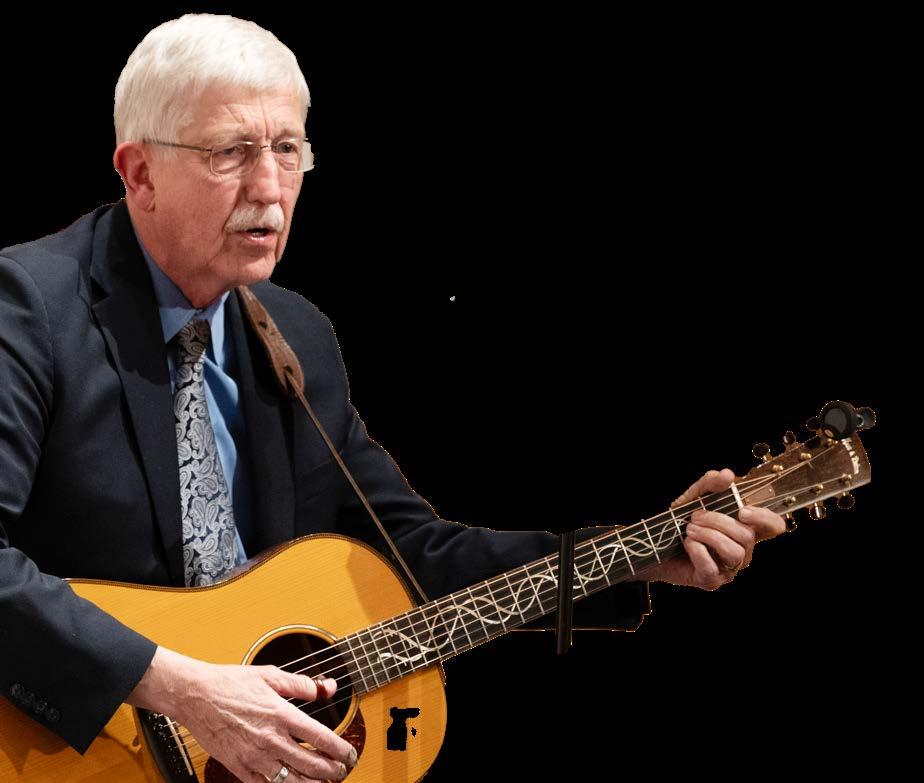






Dear Friends,
As we look forward to a fresh and exciting era of scientific collaboration with our new Jackson Laboratory (JAX) partners, it is a pleasure to share a few of the highlight achievements NYSCF has notched in recent months.
Even as we forged this exciting national alliance to ensure our long-term future, we continued our transformative medical research in New York City. NYSCF organized and hosted one of the most inspiring annual meetings in our history, at which we honored an American health hero, Dr. Francis Collins, at a milestone birthday celebration. The next day we heard reports from physicians, researchers, and scientists from around the globe. The progress they shared, together with NYSCF’s own impactful work, promises real results in the ongoing quest for treatments and cures for the most stubbornly intractable of human diseases.

NYSCF’s NYC Council member
Erik Bottcher (top right) tours the lab with NYSCF President and CEO
Jennifer Raab
Jennifer Raab with Ginger Feuer-Leeds (left) and Larry Leeds (right) in Palm Beach before Jennifer’s Coudert Institute Luncheon Lecture
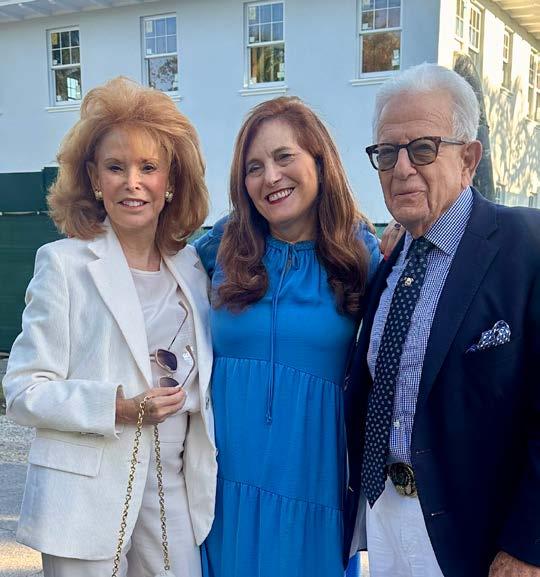
NYSCF also reached a “proof of concept” milestone this year in launching our first major commercial project using our AI powered platform for cell modeling and drug discovery. Please learn more about our $5 million deal with Johnson and Johnson on page 9.
Throughout this period of achievement and change, it has been a joy and honor to serve as your President and CEO. Together we have enlisted new research allies, generated untapped avenues of support from private and government benefactors, introduced our work to a wider public, and maximized our AI-generated medical research, bolstered by our genetically diverse biobank of stem cell lines.
I cannot thank you enough for your ongoing interest and generosity. Even as our research accelerates and our operations widen, it is the core of scientists and administrators on staff at NYSCF whose acclaimed work has captured attention and investment from the pharmaceutical industry, disease research foundations, and government funders, opening wide the doors to our future and long-term viability.
Please enjoy the updates that follow. It has been a momentous period of achievement and change. Now, we look forward to engaging all of you in the new JAXNYSCF collaborative. I know you will agree with me that the best is yet to come.
With appreciation and best regards,

Jennifer J. Raab President and CEO
Roy Geronemus, MD, Chair
Marilyn G. Breslow
Karen E. Burke, MD, PhD
Francesco Clark
Paul Goldberger

Board of Directors
Richard J. Massey, PhD
Paul M. Meister
Siddhartha Mukherjee, MD, DPhil
Stephen M. Ross
Derrick Rossi, PhD
Stephen M. Scherr
Kay Unger
Clyde Williams

The Maine-based Jackson Laboratory (JAX) and NYSCF have announced a landmark alliance to transform disease research and accelerate the discovery of life-changing therapies and cures. Driven by a shared mission to advance human health, the new partnership unifies two world-renowned scientific organizations committed to pushing the boundaries of biomedical innovation.
By unifying JAX’s expertise in genomics and disease modeling with NYSCF’s state-of-the-art stem cell technologies and building on both organizations’ strengths in biomedical data science, the alliance will create a powerful, integrated platform for biomedical discovery. This new model will accelerate the pace at which scientific breakthroughs translate into real-world
treatments, combining academic expertise in scientific research with the translational strengths of the biotechnology and pharmaceutical sectors.
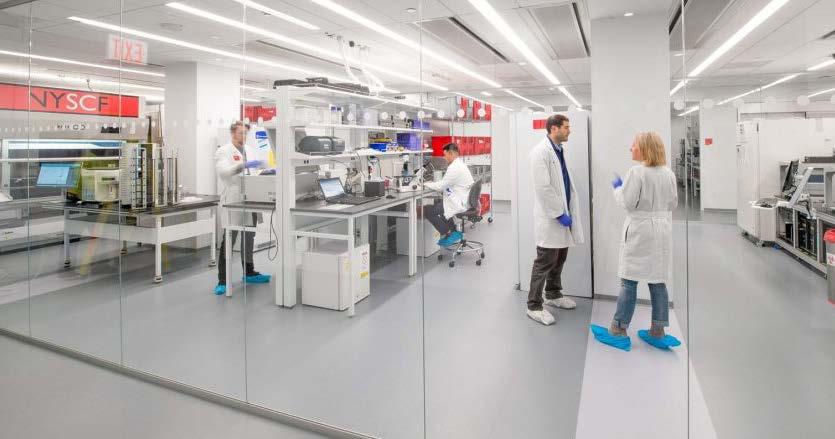



“This is a transformative moment. Through the integration of our complementary strengths in genomics, stem cell science, and AI-driven biomedical analytics, we’re building a next-generation discovery engine – one that will overcome long-standing barriers in drug development and deliver therapies to patients, faster.”
JAX President and CEO, Lon Cardon, Ph.D., FMedSci
JAX will assume NYSCF’s operations and assets, subject to the required approval by the New York Attorney General. The combined organization will be managed from The Jackson Laboratory’s headquarters in Bar Harbor, Maine, where JAX has led groundbreaking biomedical research for nearly 100 years. NYSCF’s state-of-the-art research facility in Manhattan—provisionally renamed the JAX-NYSCF Collaborative— will continue operations as a key site within JAX’s global network of campuses, reinforcing our expanding commitment to scientific collaboration and long-term growth across leading research hubs. Internationally recognized for its trailblazing work in genomics and mouse models, JAX research has laid the foundation for countless medical breakthroughs. NYSCF brings deep expertise in stem cell science and advanced automation technologies that have been instrumental in tackling the major diseases of our time. Individually, each organization leads in its field. Jointly, we will create a novel framework for discovery that no single institution could build alone.
A cornerstone of the alliance is the NYSCF Global Stem Cell Array®, a cutting-edge robotic platform that facilitates large-scale, reproducible stem cell research.

“This represents an opportunity to expand scientific research in New York City and is a giant step for global scientific progress. By joining forces now to integrate our technologies and expertise, we are creating an extraordinary environment to accelerate cures and improve health worldwide.”
NYSCF President and CEO, Jennifer J. Raab
This technology automates the creation of patient-specific stem cells, offering unprecedented precision and scalability in understanding disease and testing treatments, bolstered by its uniquely diverse biobank. When paired with JAX’s advanced capabilities and quality standards, the combination will unlock new insights into disease mechanisms and therapeutic responses at a scale never before possible.
The partnership will immediately expand efforts in areas where both institutions already lead, including Alzheimer’s and Parkinson’s diseases, cancer, diabetes, rare diseases, and diseases of the eye, bringing hope to millions of patients around the globe.

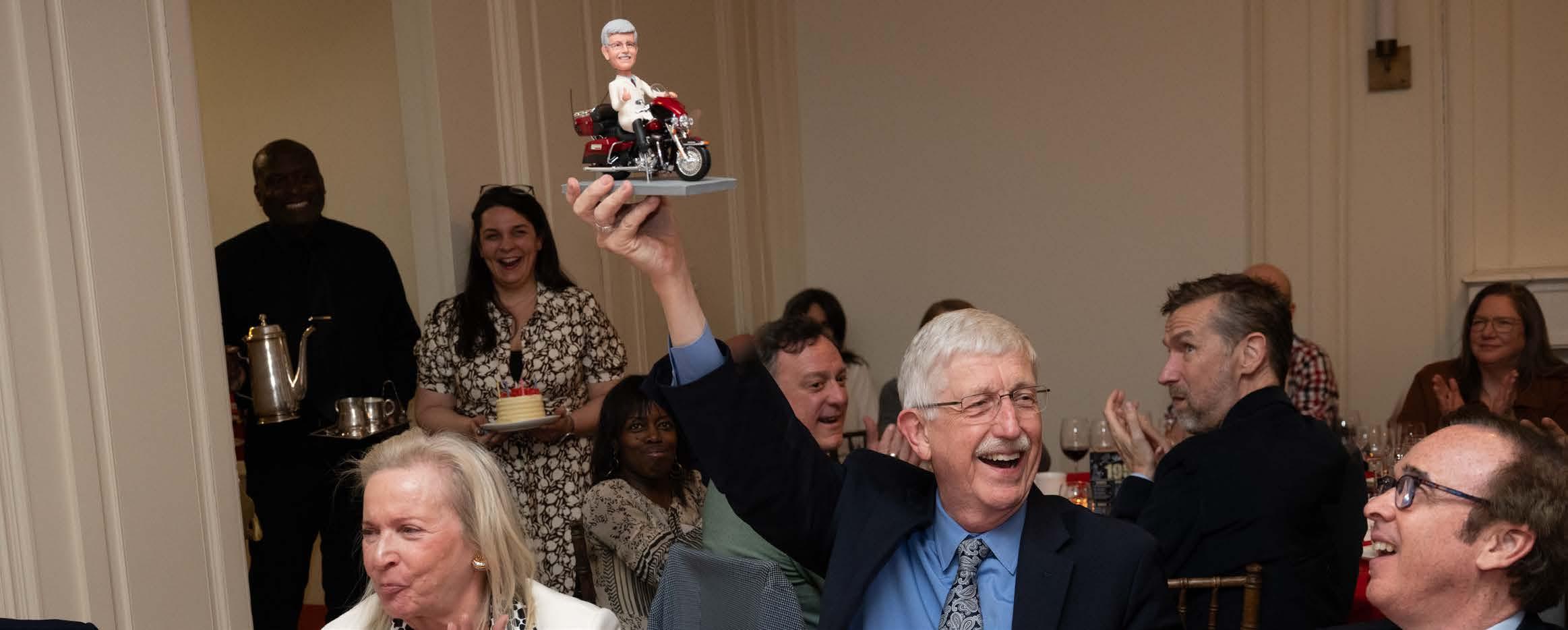
We opened our 2025 annual meeting with a tribute to—and illuminating public conversation with—a legendary public health champion: physician and scientist Dr. Francis Collins, who for sixteen years served under three American Presidents as Director of the National Institutes of Health. With characteristic grace and modesty, Dr. Collins talked frankly about the challenges he—and the nation—confronted during “the terrible stress” of the 2020-2021 COVID pandemic, “when we got even more polarized and divided and it became harder and harder for people to figure out what was true—when even objective truth began to be a questionable subject.”
NYSCF President and CEO Jennifer Raab called Dr. Collins “America’s research physician extraordinaire and one of the most influential health heroes of the 21st century”. Adding, “we all remember that Dr. Collins served tirelessly as NIH director, but he also notably led the National Human Genome Research Project before and after his tenure there. He was widely and deservedly known as one of America’s most relentless and innovative


‘gene hunters.’ At heart—not unlike NYSCF and its own wonderful team of scientists, Dr. Collins is an explorer dedicated to unblocking the secrets of stubborn diseases and curing them through visionary research.”
Dr. Collins took the stage for a revealing conversation with Dr. Jonathan LaPook affiliated gastroenterologist and Chief Medical Correspondent for CBS News—hailed by Dr. Collins as “the best medical reporter alive today.”
Dr. Collins’ New York visit coincided with his 75th birthday, which he and his wife Diane generously agreed to celebrate with NYSCF at Hunter College’s Roosevelt House. It proved the perfect setting. The onetime home of Franklin and Eleanor Roosevelt, this landmark building on East 65th Street, now a public policy institute, was preserved, restored and repurposed by NYSCF President and CEO Jennifer Raab during her twenty-two-year tenure as Hunter College President. Decades earlier, President-elect Roosevelt and his Brain Trust conceived many New Deal safety net programs— embracing an unprecedented commitment to improving




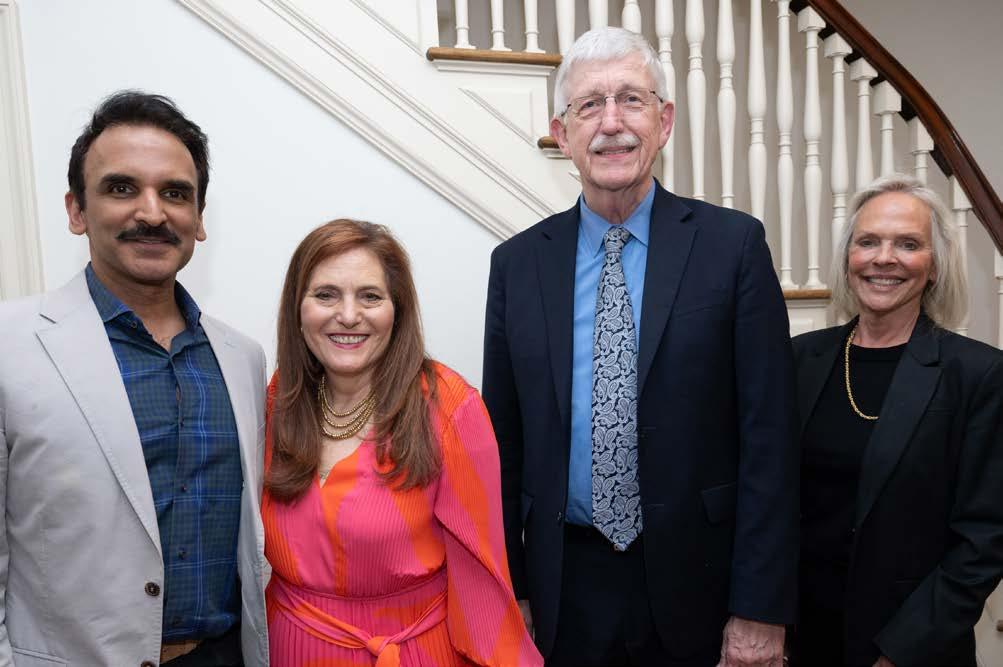

(L-R) Senior VP of Life Sciences & Healthcare at NYCEDC Viq Pervaaz, NYSCF President and CEO Jennifer Raab, former Director of the NIH Dr. Francis Collins, and Senior VP of Life Sciences at NYS Empire State Development Corporation Dr. Maria Mitchell

public health—right under this very roof. FDR made sure the New Deal included the building of hospitals, the opening of community health clinics, and something brand-new: government investment in medical research—highlighted by the creation of the National Cancer Institute and expansion of Dr. Collins’ future home, the National Institutes of Health.
During their “Fireside Chat,” Dr. Collins revealed that his musician father had once received a personal letter from Eleanor Roosevelt in anticipation of a concert he was giving in West Virginia in 1936. He also revisited the medical triumphs that the COVID crisis inspired (the warp-speed testing, production, and distribution of vaccines); the controversies it generated to his regret (over mandated lockdowns and vaccination); along with some of the personal lessons learned (including, “the requirement that when we disagree we cannot be disagreeable”). Dr. LaPook lauded Dr. Collins many “gifts” to


the nation in terms of scientific research, but above all stressed his “gift of tone—his respect for others.”
Now retired from NIH, Dr. Collins insisted, “I have not worked as hard since 2020.” Dr. Collins highlighted his work with NYSCF to automate the production of pancreatic organoids which facilitate research on the genetic causes of type 2 diabetes. He offered a heartfelt tribute to NYSCF, lauding its “remarkable scientists,” and its innovative, error-free “automated” robotic system. NYSCF in turn thanked Dr. Collins with a special birthday gift—a lookalike bobblehead bestriding a toy motorcycle (cycling and guitar remain this Renaissance man’s extracurricular passions).
Dr. Francis Collins capped this launch of the 2025 NYSCF Conference with a guitar performance that Eleanor Roosevelt herself would have applauded.



Disease don’t care if you are a big New York star, Disease don’t care if you just live in your car, Disease don’t care if you just go with the flow, Disease don’t even care if you are a CEO.
So come on people, won’t you join me, please? Let’s get it all together now and knock out disease!



This April, NYSCF convened biomedical leaders from across academia, industry, government and non-profits to discuss cutting-edge research at the 19th annual NYSCF Conference. This year’s conference, held for the first time at Hunter College, empowered scientists to share their work and build new collaborations.
With AI already revolutionizing science research, pioneers at the intersection of AI and biomedicine met for a timely exploration of how AI technology can accelerate the quest for cures. Moderated by Endpoints News’ Senior Biopharma
Correspondent Andrew Dunn, the panel featured: Anastasia Gamick, Convergent Research; Grant Mitchell, MD, Every Cure; Justin Scheer, PhD, Johnson & Johnson; and Vega Shah, PhD, NVIDIA. Their conclusion: AI is poised to transform robotic automation and drug discovery.
Launching a new biotech requires determination, financing, and big ideas. That was the conclusion shared by experienced leaders in the VC and biotech startup space. Matthew Herper of STAT News moderated a discussion featuring Karen Heidelberger, Deerfield Management; John Mendlein, PhD, Flagship Pioneering; Viq Pervaaz, NYC Economic Development Corporation; and Carlo Rizzuto, PhD, Versant Ventures. Audience members honed in on the balance of profit and public good in biomedical research and asked how entrepreneurial researchers can best fund their dream startups.
Over 100 scientists presented their exciting research at our cocktail poster reception. Poster sessions are a crucial opportunity for informal discussion between researchers at different institutions, leading to innovative ideas and bold new collaborations.

“NYCEDC is excited with the work that NYSCF is leading on how to use AI and machine learning, to discover new therapies for debilitating diseases like Alzheimer’s, Parkinson’s, multiple sclerosis, and macular degeneration.”
- NYCEDC President and CEO, Andrew Kimball



UNDERWRITING SUPPORT
UNDERWRITING SUPPORT
LIFE SCIENCES DRIVING ECONOMIC DEVELOPMENT IN NYC
Andrew Kimball, President and CEO of the New York Economic Development Corporation (NYCEDC), opened the conference with remarks highlighting the crucial investments NYCEDC has made in New York’s biomedical infrastructure. These investments are fueling NYC’s rapid emergence as a global leader in biomedical research.
SUSAN L. SOLOMON MEMORIAL KEYNOTE ADDRESS
NYSCF–Robertson Investigator alumna Paola Arlotta, PhD (Golub Family Professor of Stem Cell and Regenerative Biology at Harvard University) delivered the Susan L. Solomon memorial lecture. Dr. Arlotta captivated the audience with unpublished data on her groundbreaking ‘chimeroids’ (mini-brains made from the cells of multiple patients.) Her lab is using chimeroids to study how different the brain cells of different people respond to treatments in different ways.
Type 1 diabetes researcher Sonja Schrepfer, MD, PhD (Sana Biotechnology) revealed that they can now engineer insulin producing cells that avoid the immune system. These cells were transplanted into humans and show stable insulin production, providing hope for a type 1 diabetes treatment that doesn’t require immune suppression.
Denise and Michael Kellen Foundation
UNDERWRITERS
Denise and Michael Kellen Foundation
BENEFACTORS
BENEFACTORS
BENEFACTORS
Gina Argento
Karen E. Burke, MD, PhD & Peter J. Goulandris
Gina Argento
Doris Duke Foundation
Gail and Roy Geronemus, MD
Karen E. Burke, MD, PhD & Peter J. Goulandris
Marina Breshteyn, PhD (Neurona Therapeutics) discussed her groundbreaking research on a stem cell treatment for epilepsy. Researchers at Neurona create stem cells from blood, then turn these stem cells into neurons which are implanted into epilepsy patients. Dr. Bershteyn showed promising preliminary clinical data.
Doris Duke Foundation
McNulty Foundation
NYSCF – Robertson Investigator Alumni
The Richard J. Massey & Tarra Bandet Foundation for Arts and Sciences
Gail and Roy Geronemus, MD McNulty Foundation
NYSCF – Robertson Investigator Alumni
Kay Unger Family Foundation
The Richard J. Massey & Tarra Bandet Foundation for Arts and Sciences
Kay Unger Family Foundation

Sometimes, personal experience can fuel accelerated research and promise advanced cures. Eight years ago at the age of 49, Jonathan Silverstein received a grim diagnosis: Parkinson’s disease (PD) with a mutation in the GBA gene (PD-GBA). This particularly aggressive form of PD is still poorly understood relative to other forms of the disease, and treatment options remain elusive. Silverstein, a successful health care venture capitalist at OrbiMed, immediately directed his professional expertise, fueled by personal urgency, to accelerating a cure for patients. With his wife Natalie, he established The Silverstein Foundation for Parkinson’s with GBA.
Recognizing the lack of progress in finding a cure for PD using traditional models, Silverstein invested in the


NYSCF is honored to have the support of the Silverstein Foundation as we push the boundaries of PD-GBA research. Through our partnership, NYSCF has built the world’s largest collection of stem cells from patients with PD-GBA.
potential of induced pluripotent stem cells (iPSCs). In 2022, The Silverstein Foundation approached NYSCF about a partnership centered around our unique technology platform, the NYSCF Global Stem Cell Array® (“the Array”), which combines automation, cell imaging, and machine learning. While iPSCs hold extraordinary promise for the study and treatment of diseases like PD-GBA, a lack of iPSCs with GBA mutations proved an impediment to progress. With support from The Silverstein Foundation, NYSCF set out to address this challenge by using our Array to create a large repository of PD-GBA cells.
Through our Silverstein partnership, NYSCF built the world’s largest collection of iPSCs made from patients with PD-GBA, which is now available to the wider research community. To
NYSCF is proud to welcome our second Visiting Scholar: Dr. Vikram Khurana , a world-renowned research scientist and clinician. Dr. Khurana is Chief of the Movement Disorders Division at Brigham and Women’s Hospital, Associate Professor of Neurology at Harvard Medical School, and 2018 NYSCF–Robertson Stem Cell Investigator alumnus. Our new Visiting Scholar is recognized for his work by the American Parkinson’s Disease Association, Department of Defense, the American Brain Foundation, and the NIH. NYSCF launched the Visiting Scholars Program to provide mentorship for our scientists and to enrich our research collaborations. We are honored to have Dr. Khurana and his research fellow, Dr. Alain Ndayisaba , here at NYSCF to bring their expertise to our pioneering work in understanding and developing better treatments for Parkinson’s disease.
date, NYSCF’s analysis of these cells has resulted in a massive dataset of PDGBA cell images – an unprecedented 20 terabytes of information. We have used this extensive dataset to train an algorithm to recognize images of PDGBA cells. Because the algorithm can distinguish PD-GBA cells from healthy cells by discerning subtle differences in cellular features that are invisible to the human eye, it enables us to identify any compounds that make the PD-GBA cells look “healthy.” Most recently, after testing 989 compounds on our PDGBA cells, this algorithm identified 14 potential therapeutic solutions. This is a significant step toward identifying drugs that could slow or even stop progression of the disease.
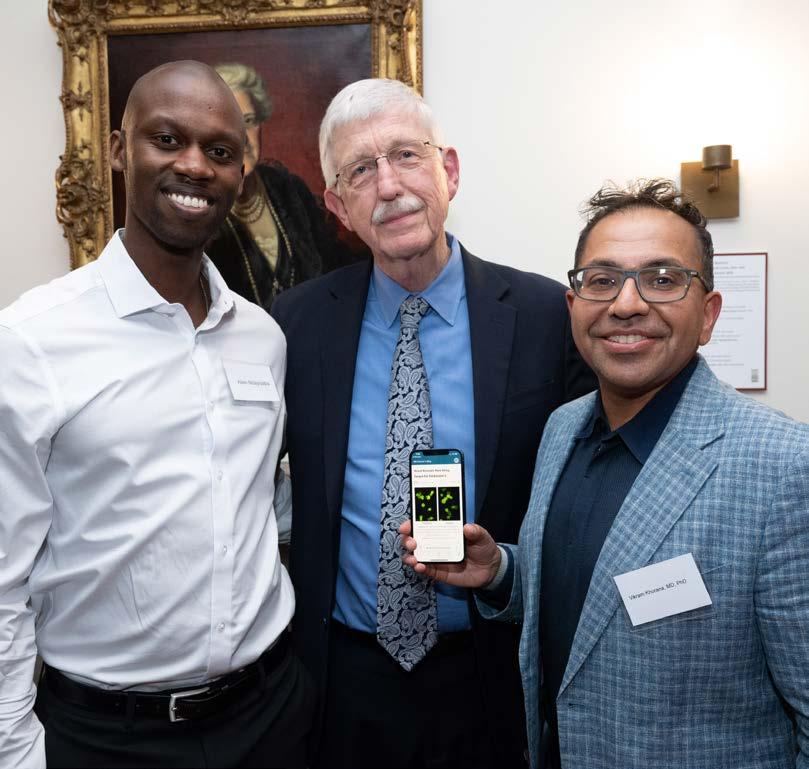

As NYSCF celebrates our 20th anniversary this year, we mark a significant milestone in meeting our founding mission: developing better treatments and cures for patients. Through a new $5 million partnership with Janssen Research & Development, a Johnson & Johnson company, NYSCF is deploying our AI-powered platform for drug discovery to target neurodegenerative disease.
This initiative—NYSCF’s first major commercial partnership—brings together NYSCF’s advanced robotic systems for stem cell research with J&J’s expertise in drug discovery and data science to accelerate the development
of more effective tailored treatments and cures.
J&J approached NYSCF to utilize our pioneering automation platform, which allows us to produce patientderived stem cells at unprecedented scale. By creating stem cells from the blood or skin of hundreds of patients, we can better understand why diseases and treatments affect different people in different ways—allowing us incomparable access and commitment to biodiversity.
Because this platform generates vast amounts of data, NYSCF previously partnered with Google to develop a machine learning platform for data analysis. Now, this unique platform will allow researchers at J&J to predict the effectiveness of potential therapies for diverse patient populations. Together, NYSCF and J&J are uniquely positioned to advance precision medicine for patients.

This Spring, NYSCF embarked on an exciting new chapter in our high school science education work by establishing a “sister-school” partnership with our West Side neighbor, Manhattan Hunter Science High School. MHSHS is the science-focused collegepreparatory high school that President Raab helped found in 2003 during her Presidency at Hunter College. The partnership will provide programming for all four grades, with a sequential curriculum that allows students to build upon their skills. Students will apply classroom knowledge to the lab, and take their lab experience to the classroom, contextualizing their education and gaining real-world experience.
Thanks to vital seed funding from The Gray Foundation, NYSCF launched the partnership this May with two days of field trips for more than 100 9th and 10th grade students from MHSHS, whose campus is located just ten blocks from our research institute. Joined by Gray Foundation President Charissa Fernandez , Gray Foundation Scientific Program Manager Dr. Alexa Strauss, and MHSHS Principal Dr. Kevin Froner, President Raab welcomed the students by sharing her vision for the fouryear pilot program.
(L-R) Gray Foundation Scientific Program Manager Dr. Alexa Strauss, Gray Foundation President Charissa Fernandez, NYSCF President Jennifer Raab, and Founding Director of the Gray Fellowship and Principal of MHSHS Dr. Kevin Froner
To kick off the day, NYSCF’s Dr. Valentina Fossati inspired the students with her Stem Cells 101 lecture on how NYSCF is harnessing the power and advancing the potential of stem cell research. The students then toured the NYSCF Research Institute, experiencing firsthand our state-of-the-art laboratory while engaging with scientists and engineers working on the platform. Concluding their day with a Career Panel of scientists, engineers, and program leaders who shared their diverse experiences, the students enjoyed an eye-opening discussion about the wide variety of career opportunities in this fast-paced, fast-growing field.

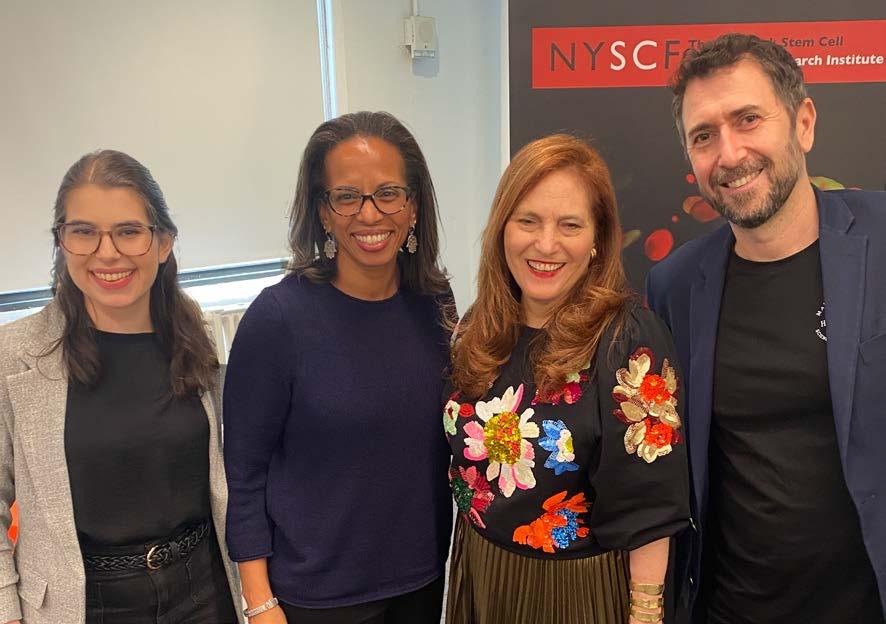
With our longstanding commitment to strengthening the STEM pipeline, NYSCF is honored to have this opportunity to work with the outstanding students at MHSHS in building their pathways to STEM careers.



Despite recent and encouraging advances in cancer research and clinical care, finding effective treatment for ovarian cancer patients remains a painstaking process of trial and error, requiring time most patients simply do not have.
The dire prognosis for this particular cancer has accentuated the desperate need for better tools to help oncologists pair the right treatment with the right patient. In tribute to NYSCF’s founding CEO Susan L. Solomon, whom we lost to ovarian cancer in 2022, NYSCF has established a trailblazing method to grow and study a patient’s tumor indefinitely in the lab. Made from the patient’s own cancer cells, the resulting “mini-


tumors,” known as organoids, can be used to test hundreds of potential therapies to ascertain the most effective compounds for each patient.
By accelerating exciting new avenues of research, organoids are helping to move the needle on potential treatments for ovarian cancer patients. For example, our research in immunotherapies has opened one promising possibility: using stem cells, we are creating natural killer cells—a type of immune cell critical to fighting tumors—and directing them against the organoids to study how each patient’s tumor responds. Our scientists have great hope that this promising technology will allow us to develop effective ovarian cancer immunotherapies.

In a similar vein, working with the Stevens Institute of Technology, we used these organoids to test the impact of taurine, a compound often found in foods and energy drinks, on tumor resistance to chemotherapy. We are now studying the implications that this might have for patients. As we continue to use our unique organoid platform to study ovarian cancer, NYSCF is advancing the promise of effective, personalized treatments for women with this deadly disease. Given that organoids can be grown from any tumor, our work also holds the potential to apply more broadly to other cancer types. NYSCF is deeply grateful for the visionary support of The Ralph and Ricky Lauren Family Foundation for our trailblazing work.
Physician-scientist, Pulitzer Prize-winning author, and NYSCF Board member Dr. Siddhartha Mukherjee on the impact of Dr. Laura Andres-Martin’s work
“Dr. Laura Andres-Martin’s team at NYSCF has built one of the largest banks in the world of ovarian cancer cells grown in organoid form. This invaluable resource will help us translate past decades of work into medicines for patients.”
Please make a gift to help NYSCF advance stem cell research toward the clinic. You can donate online at nyscf.org/donate or by mail to:
The New York Stem Cell Foundation 619 West 54th Street, 3rd Fl, New York, NY 10019
Follow us on social media!

IN MEMORIAM
REMEMBERING DR. GEORGE LAZARUS 1946 – 2025
We are mourning the loss of our devoted Board member and longtime champion, Dr. George M. Lazarus. Together with his cherished wife Shelly, George was a staunch advocate for stem cell research and an early supporter of our pioneering organization. As an esteemed New York City pediatrician and mentor, George was beloved by generations of families and trainees. His 12-year tenure on the NYSCF Board was marked by his profound compassion and wisdom. NYSCF benefited greatly from his medical expertise and insight as we worked to accelerate cures for patients around the world. George brought his lifelong commitment to elevating young people to our Education Committee, advocating for NYSCF’s STEM education and internship programs. We will forever be inspired by George’s optimism, his humanism, and his commitment to our mission.
